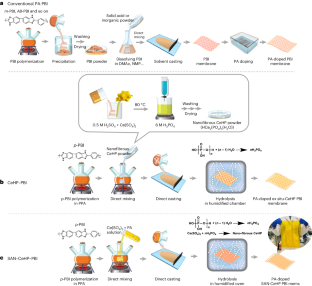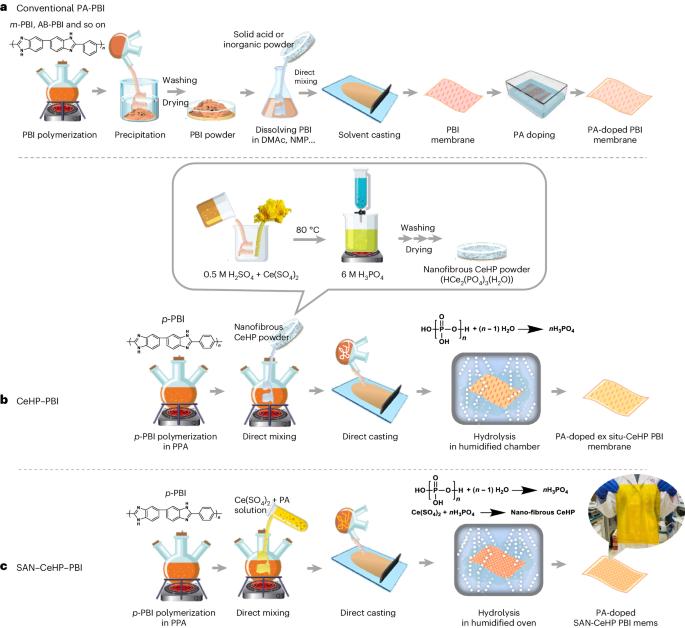在 250 °C 下应用于燃料电池的自组装网络聚合物电解质膜
IF 49.7
1区 材料科学
Q1 ENERGY & FUELS
引用次数: 0
摘要
在高温下运行聚合物电解质膜(PEM)燃料电池可简化水管理,并可与高纯度燃料处理装置集成。然而,现有的基于聚苯并咪唑(PBI)的 PEM 燃料电池由于质子传输在 160 °C 以上不稳定而面临挑战。在此,我们报告了一种由对位 PBI(p-PBI)和磷酸氢铈(CeHP)组成的 PEM,它可用于温度高达 250 ℃ 的燃料电池。在制造过程中,回声状 CeHP 粒子在 PBI 基体(SAN-CeHP-PBI)内形成了一个分散良好且相互连接的自组装网络,使其在 200 °C 以上的质子传输方面优于对位 PBI 和传统 CeHP-PBI PEM。我们报告了一种基于 SAN-CeHP-PBI 的燃料电池,其最大功率密度达到 2.35 W cm-2(250 °C,干 H2/O2),在热循环(160-240 °C,H2/空气)过程中,500 小时内的衰减可以忽略不计。SAN-CeHP-PBI 还具有出色的二氧化碳耐受性,显示了与液氢载体系统集成的前景。本文章由计算机程序翻译,如有差异,请以英文原文为准。


Self-assembled network polymer electrolyte membranes for application in fuel cells at 250 °C
Operating polymer electrolyte membrane (PEM) fuel cells at high temperatures can simplify water management and allow integration with high-purity fuel processing units. However, existing polybenzimidazole (PBI)-based PEM fuel cells face challenges due to the instability of proton transport above 160 °C. Here we report a PEM composed of para-PBI (p-PBI) and cerium hydrogen phosphate (CeHP) that can be used in a fuel cell at up to 250 °C. During fabrication, echinoid-shaped CeHP particles form a well-dispersed and interconnected self-assembled network within the PBI matrix (SAN–CeHP–PBI), allowing them to outperform p-PBI and conventional CeHP–PBI PEMs in terms of proton transport above 200 °C. We report a SAN–CeHP–PBI-based fuel cell that reaches a maximum power density of 2.35 W cm−2 (at 250 °C in dry H2/O2) with negligible degradation over 500 h during thermal cycling (at 160–240 °C, H2/air). SAN–CeHP–PBI also demonstrates excellent CO tolerance, showing promise for integration with liquid hydrogen carrier systems. High-temperature operation of polymer electrolyte membrane fuel cells has some advantages but is also challenging due to the instability of proton transport above 160 °C. Here the authors report a polymer electrolyte membrane comprising well-dispersed and interconnected cerium hydrogen phosphate particles within a polymer matrix that performs well in a fuel cell at up to 250 °C.
求助全文
通过发布文献求助,成功后即可免费获取论文全文。
去求助
来源期刊

Nature Energy
Energy-Energy Engineering and Power Technology
CiteScore
75.10
自引率
1.10%
发文量
193
期刊介绍:
Nature Energy is a monthly, online-only journal committed to showcasing the most impactful research on energy, covering everything from its generation and distribution to the societal implications of energy technologies and policies.
With a focus on exploring all facets of the ongoing energy discourse, Nature Energy delves into topics such as energy generation, storage, distribution, management, and the societal impacts of energy technologies and policies. Emphasizing studies that push the boundaries of knowledge and contribute to the development of next-generation solutions, the journal serves as a platform for the exchange of ideas among stakeholders at the forefront of the energy sector.
Maintaining the hallmark standards of the Nature brand, Nature Energy boasts a dedicated team of professional editors, a rigorous peer-review process, meticulous copy-editing and production, rapid publication times, and editorial independence.
In addition to original research articles, Nature Energy also publishes a range of content types, including Comments, Perspectives, Reviews, News & Views, Features, and Correspondence, covering a diverse array of disciplines relevant to the field of energy.
 求助内容:
求助内容: 应助结果提醒方式:
应助结果提醒方式:


